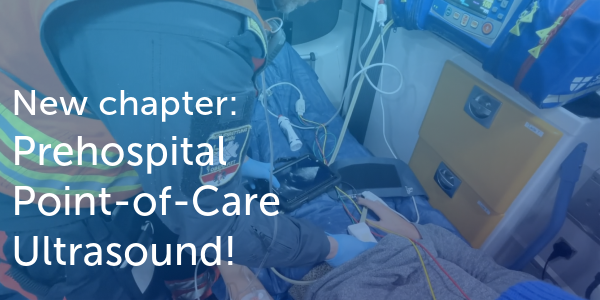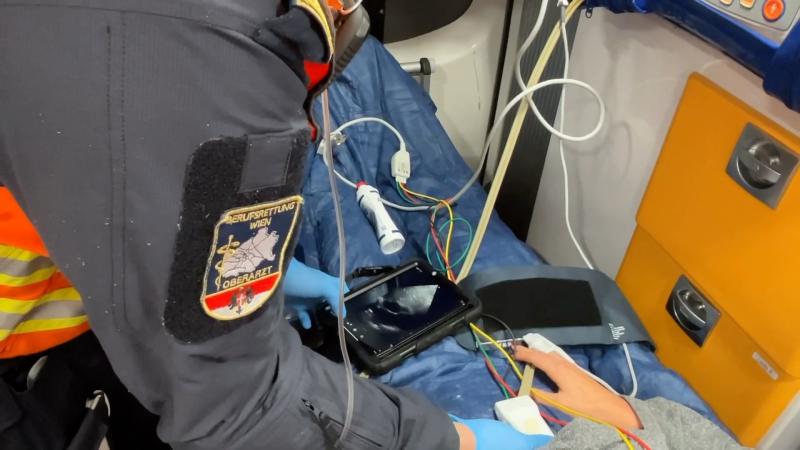Prehospital Emergency Medicine – pPOCUS ties us together!
The accessibility of prehospital and emergency healthcare, as well as the involvement of different healthcare professionals as prehospital care providers, varies significantly across countries and regions worldwide. This is due to variations in emergency medical services (EMS) systems, levels of training, scopes of practice, equipment availability, and healthcare infrastructure, among other factors.
Let's consider a patient case involving a 25-year-old woman who experiences severe dyspnea in two different scenarios. In both cases, she is a non-smoker, active in sports, and takes birth control pills. Although her symptoms are the same, her access to healthcare differs significantly. What ties the two scenarios together is the benefit of including ultrasound exams in the prehospital assessment of patients.
Scenario 1:
For scenario 1, imagine an urban area in the UK, Germany, Belgium, France or the US with a rather robust healthcare system and POCUS-equipped and trained paramedics with or without physician on the ambulance car.
Our hypothetical patient is benefiting from a robust public healthcare system in her country. She lives in a city with access to advanced medical facilities. When she experiences severe shortness of breath at home, her family or neighbor quickly calls the emergency number. An ambulance arrives within 10 minutes, and paramedics conduct an initial assessment suspecting a life-threatening condition based on the low oxygen saturation. The arterial blood pressure is 90/50 mm Hg, respiratory rate is 25, heart rate is 130 bpm, and blood oxygen saturation is 86%. The woman has no swelling or pain in her legs. The ECG shows tachycardia. One of the most experienced paramedics has learned point-of-care ultrasound (POCUS) in one of the country's first education programs for paramedics and performs a targeted lung and heart ultrasound following the organization’s protocols en route to the hospital. Signs of pulmonary embolism (PE) are identified, including right ventricular dilation and pulmonary artery dilation. Compression sonography of the legs shows no thrombus formation in the 3 venous levels assessed. Upon arrival at the hospital, additional tests including D-dimer levels and chest CT angiography confirm the diagnosis.
Immediate anticoagulation therapy is started, with a comprehensive treatment plan developed, which may involve thrombolysis or surgery. From the initial call to confirmed diagnosis takes about 1-2 hours, and treatment is administered within 3-4 hours of hospital arrival. The pPOCUS conducted by a trained paramedic provides sonographic support for the initial suspicion or clinical working diagnosis, impacting time and team management, operational tactics, and acute measures.
In the next paragraph, we will contrast this with a scenario where the patient experiences the same symptoms while on vacation on a small Pacific island.
Scenario 2:
Vacation on a small Pacific island – Health center with one or two general practitioners and several nurses
On a small island in the Pacific, a woman experiences severe shortness of breath 2 days after arrival. She has no swelling or pain in her legs. The island has limited resources compared to the main island and urban areas. The local healthcare system includes essential facilities. Locals from the beach take her to a local clinic where a nurse or general practitioner performs an initial physical assessment: Arterial Blood Pressure 90/50 mm Hg, Respiratory Rate 25, Heart Rate 130 bpm, SpO2 86%, T 36°C. Language barriers can be overcome with the help of text translation.
Let’s imagine local healthcare facilities investing in a portable POCUS machine. A nurse, who is also trained in basic obstetrics/gynaecology and emergency ultrasound, uses the machine to perform lung ultrasound (to rule out pneumothorax), and obtain a subcostal four-chamber view in a short echo exam. She also performs 3-point DVT compression sonography. She saves several loops and discusses them with the doctor and they contact the hospital on the main island, where they report the patient's condition, and share their finding of a severely dilated right ventricle. Depending on the technical possibilities, images could also be transferred to a specialist via telemedicine. Based on the findings, there is a strong suspicion of pulmonary embolism.
To summarize, the early POCUS assessment can significantly reduce the time to diagnosis. This means not waiting for blood tests to be sent to the main island, not being completely dependent on physical exams (she had no swelling or pain in the leg), no reliance on ECG signs of PE that are often absent and non-specific, and fewer wrong treatment directions being taken. Overall, this easily saves 2-10 hours in time-to-diagnosis. Subsequently, the quick decision to transport the patient to a specialized clinic and/or start treatment in the primary hospital could save up to half the time-to-treatment, ultimately improving patient outcomes. Upon arrival at the hospital on the main island, lab tests are performed to corroborate the diagnosis and treatment is started, similar to that in the first scenario!
Producing a pPOCUS Course:
We are excited to announce the launch of our latest course, Prehospital Point-of-Care Ultrasound (pPOCUS). This course is designed to enhance the skills of paramedics and physicians working in prehospital settings and at the intersection with clinical emergency medicine, anaesthesia, and intensive care. Our goal is to contribute to the standardisation and quality assurance of training programs in prehospital emergency medicine internationally. This course will be integrated into the training programs of our collaboration partner, Berufsrettung Wien (EMS Vienna), to enrich the education of paramedics and prehospital physicians.
Feasibility of Prehospital POCUS and Impacts on Patient Management:
Studies have shown that pPOCUS is feasible in diverse prehospital environments, including ground and air medical services. Modern ultrasound devices' portability and ease of use make them suitable for rapid deployment. However, effective implementation requires adequate training, highlighting the need for comprehensive education programs (1,2). Implementing pPOCUS can significantly enhance diagnostic accuracy and influence clinical decision-making in the field. For instance, it aids in identifying life-threatening conditions like internal bleeding and pneumothorax, leading to timely and appropriate interventions. This can result in changes to treatment plans and more informed decisions regarding patient transport and on-site management (3,4).
Education of Providers - Quality and Standardization:
Training and ongoing education are critical for the effective use of pPOCUS. Our tailored program covers technical and interpretive skills suitable for different skill levels, from basic EMTs to advanced paramedics and emergency physicians. We are committed to supporting the global integration of pPOCUS by offering comprehensive courses for EMS systems worldwide. Our aim is to get regulatory and policy support, encouraging the inclusion of pPOCUS in EMS personnel's scope of practice and exploring ways to incorporate online training globally.
Join Us in Transforming Prehospital Care:
The first two chapters of the course are already available! Another 4 chapters, equally packed with cases, demos, and sequences live from emergency scenes, follow shortly. A special Add-On Chapter allows you to dive deeper into the intersection of prehospital and clinical emergency care.
By enrolling in our course, you will gain the skills to apply pPOCUS across diverse prehospital scenarios and earn 6 CME credits. Take advantage of our exclusive launch offer and start learning today! Get 40% plus Lifetime Access to the course here!
Sources:
- Portable ultrasound devices suitable for rapid deployment: Becker TK, Martin-Gill C, Callaway CW, et al. "Feasibility of prehospital point-of-care ultrasound." Prehosp Emerg Care. 2010;14(2):155-160.
- Adequate training requirements: McDermott C, Stefan G, Wallner S, et al. "Prehospital ultrasound: training and competency for medical staff." Am J Emerg Med. 2012;30(9):1838-1844.
- Enhanced diagnostic accuracy and timely interventions: Press GM, Miller SK, Hassan IA, et al. "Prospective evaluation of prehospital trauma ultrasound during aeromedical transport." J Emerg Med. 2014;47(6):638-645.
- Influence on clinical decision-making: Heegaard W, Hildebrandt D, Spear D, et al. "Prehospital ultrasound by paramedics: results of field trial." Acad Emerg Med. 2010;17(6):624-630.
- Importance of structured training programs: Filopei J, Siedenburg H, Rattner P, et al. "Prehospital ultrasound education and usage: impacts on diagnosis and treatment." Ultrasound J. 2013;35(2):205-212.



